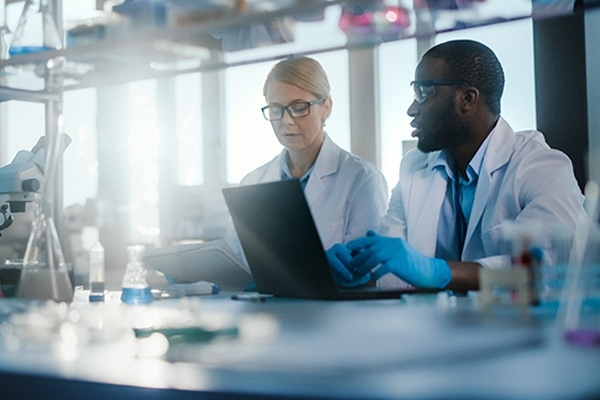- Bioprocess Insider
- Sponsored Content

What’s new in AAV manufacturing? 3 takeaways from Thermo Fisher Scientific
December 6, 2021

Sponsored by Thermo Fisher Scientific
From virtual regulatory inspections to optimization of scalable AAV production, the gene and cell therapy fields continued to innovate and evolve throughout the pandemic.
Thermo Fisher Scientific hosted an interactive workshop highlighting some of these developments, including a new AAV production system, a custom media platform for viral production cell lines, and changes to the regulatory process. Read on to get a taste of those insights.
A Helper-Free AAV Production System

Adeno-associated viruses (AAVs) are among the most promising gene delivery vectors both as a basic research tool, and as a gene therapy tool. For both applications, access to a simplified and scalable production protocol for high-quality recombinant AAV vectors is crucial.
AAVs are replication-defective and therefore require the addition of essential replication genes, complicating the process. AAV replication has traditionally been achieved through co-infection with a “helper” virus, but these are difficult to remove during purification and can cause side effects when used in a clinical setting.
Thermo Fisher’s Senior Manager of R&D in Cell Biology, Chao Yan Liu, M.D., offered workshop attendees a sneak peek at a promising alternative: the AAV-Max Helper-Free AAV Production System, which will be launched in Q3 of 2021. Currently designated for research use only (RUO), it features a complete helper-free AAV production system that uses triple transfection technology in a suspension HEK293 production cell line, eliminating the need for helper viruses.
Optimizing Cell Culture Media for Viral Vector Production
Optimized cell culture media can dramatically increase viral vector titers, allowing gene and cell therapy developers to improve their yields and streamline their processes. Gino Stolfa, Ph.D., a staff scientist in Thermo Fisher’s Molecular Biology division, discussed the reliable and scalable culturing of a broad range of HEK293 cell lines.
HEK293 cell lineages differ in their gene expression profiles. Compounding this complexity, these cells’ metabolisms are sensitive to suspension-based culturing. To account for this diversity and different viral production processes, Thermo Fisher developed the Viral Vector HEK Media Panel, which can significantly improve production efficiency.
The media library is specifically designed for HEK293 cells, with five chemically defined formulations to choose from. It supports rapid customization for improved viral titers and is compatible with a range of transfection methods and workflow processes.
In the workshop, Dr. Stolfa provided an overview of a study that tested the media panel using HEK293 clones with different pre-optimized processes. The media panel’s five formulations covered a wide range of cell culture components and concentrations. Viral titers increased up to 10-fold with little to no effect on cell growth.
Virtual Inspections: Navigating Client and Agency Audits During the Pandemic
Due to the SARS-CoV-2 pandemic, regulators have identified challenges to their workload, including the inability to meet target inspection deadlines and the FDA’s delayed approval of marketing applications.
Monica Commerford, Ph.D., Head of Regulatory Affairs for Patheon Viral Vector Services, presented a case study on the shift to virtual inspections that has allowed the FDA to continue mission-critical regulatory commitments.
“The cell and gene therapy universe is really exploding right now because of a common mission that we have, which is the rush to find cures for patients,” noted Commerford.
According to Dr. Commerford, Thermo Fisher’s prior use of virtual inspections helped the company avoid significant workflow delays, maintaining continuity without sacrificing client and regulatory responsibilities.
Virtual inspection capabilities support both client audits and inspections from regulatory agencies. Thermo Fisher’s approach includes tailored solutions specific to the biopharmaceutical industry. For virtual tours of GMP facilities, a 360° camera can be attached to a cell phone or iPad to offer a close-to-real world view. If needed during the tour, the camera’s advanced technology can be used to read documents, labels, and logbooks. Microsoft HoloLens adds another dimension, allowing individuals to perform activities in a spatially dynamic environment, enabled by the 360° camera.
For more information on these developments in AAV manufacturing, view the full workshop here
About the Author
You May Also Like


